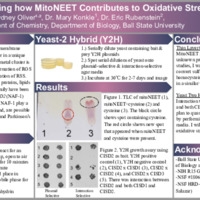Browse Exhibits (1 total)
Sydney Oliver | Understanding how MitoNEET Contributes to Oxidative Stress

MitoNEET is a outer mitochondrial membrane protein that contains a [2Fe-2S] cluster. Since its discovery, three genes of the protein family have been identified as CISD1 (mitoNEET), CISD2 (NAF-1), and CISD3 (Miner 2). If the metal cluster is lost from NEET proteins, it can cause oxidative stress because free iron causes the formation of reactive oxygen species (ROS) which can then go on to cause the formation of reactive sulfur species (RSS). These reactive species cause damage to proteins, lipids or DNA. MitoNEET and NAF-1 play unclear role(s) in resistance to oxidative stress and are possible drug targets for cancer cell, diabetes, and Parkinson’s Disease. In my project I have started to explore how 1.) mitoNEET contributes to sulfur-metabolism in human biochemistry and 2.) how NEET proteins interact with each other. This study is impactful because oxidative stress in cells is strongly influenced by the balance between ROS and RSS. I am completing this project to understand how the chemistry of mitoNEET impacts RSS and then extending this knowledge into yeast cells to examine the results in a cellular environment under oxidative stress. The primary research methodology of thin-layer chromatography showed that a new chemical is being made when the amino acid cysteine is combined with mitoNEET. This result indicates an enzymatic function of mitoNEET that would integrate into maintaining cellular redox balance. Additionally, yeast-2 hybrid experiments have shown an interaction between NAF-1 with itself and NAF-1 with mitoNEET. Future studies will extend this work by examining how NAF-1 interactions in yeast cells are impacted by oxidative stress.
Faculty Mentor: Mary Konkle
Biology
Graduate
